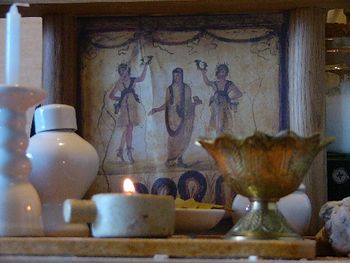"An altar is any structure upon which offerings such as sacrifices are made for religious purposes. Altars are usually found at shrines, and they can be located in temples, churches and other places of worship. Today they are used particularly in Christianity, Buddhism, Hinduism, Shinto, Taoism, as well as in Neopaganism and Ceremonial Magic. Judaism did so until the destruction of the Second Temple. Many historical faiths also made use of them, including Greek and Norse religion."
-Wikipedia Definition of Altar
The use of altars within most Neopagan traditions come from it's use within Ceremonial Magic. Also known as the "Working Altar". Most Neopagans also make use of Devotional Altars of Shrines, of which my personal Altar is. In fact, in most religions, Devotional Shrines, or even Devotional Oratories or Chapels, are set up in homes. Within Japanese traditions, like Shinto and Tenrikyo, the Kamidana is a common sight in many homes. Another example being the "Red Corner" in many Russian Orthodox homes, containing images of the saints and the Theotokos. The Red Corner is so ingrained withing Russian culture, that during the Soviet Era, the idea of putting up pictures of Valdimir Lenin and other communist figures was promoted.
This is my personal Devotional Altar. It's a nightstand with a metal plate to make a flat space (the top came with an indentation). On it are two bandana's making the altar cloth, alongside an incense stick holder, a pentacle on an octagonal piece of slate surrounded by five tumbled gems, a dagger, a wand, two offering dishes (read: shells, its an interesting touch), a stand with a yellow gold altar cloth. The statues depict Auset (Isis) and Dionysus, as well as a statue of Horus (representing Ra-Hoor-Khuit). On the sill I have some small jugs to hold libation offerings, candles, and a bell. Also on the sill are statues of Djehuty (Thoth), Columbia, and the bodhisattva Budai. Images of Auset and Baphomet also grace the sill.
I wouldn't say that the collection is Eclectic in any way, since I consider myself a Hermetic Magician/Thelemite. The presence of Budai and Columbia are there for specific reason as well. Being born and raised as an American Columbia is in many ways a patron. The adoption of her worship by Pagans and others is sometimes thought of as controversial, picking up a lot of steam during the Hail Columbia campaign to mystically fight back against the DC 50 prayer campaign launched by the New Apostolic Reformation. Budai, not only being a well syncretised and acculturated deity in the West, is also there representing the influence Buddhism has had on my personal faith.
Neopagan and Hermetic tradition have in many ways revived the Home Devotional Altar tradition that died off after the Protestant Reformation. What most people that do not have one don't tend to realize is the psycho-spiritual effect it has on your life. The altar is a promise, to keep the Divine important in your life. Of course, the importance of the Divine in orthopraxic religions is different than in orthodoxic religions, but I digress. The altar is not only a devotional space, but a work of art as well. While you do not need a lot of money to make an altar, you should try to make it a grand and wonderful spot What you have is a throne, a seat for the Gods to sit in and come dwell with you.
I inspired my sister, a Presbyterian, and my close friend, who was born and raised Catholic but is now just Christian, to put up altars in their own ways, and they still thank me.
Something that is not commonly seen, but is a growing presence within our traditions is the existance of ancestor altars and altars devoted to the smaller household gods, like the Larariums of old. We spend all our days thinking of the bigger picture, and yet we do not think of the things that, without them, all this would not be possible. I will admit that I am among those who do not have such a shrine, but one day I will, one day. But for now, I thank them in my heart, which is the truest altar anyone can carry around, the altar given to us at birth.
NEXT WEEK: Aradia, the Gospel of the Witches



No comments:
Post a Comment